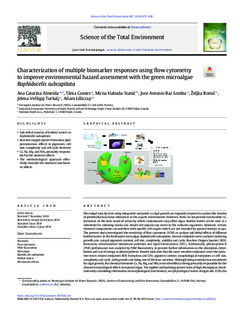| dc.description.abstract | Microalgal toxicity tests using integrative endpoints as algal growth are regularly required to analyse the toxicity of potentially hazardous substances in the aquatic environment. However, these do not provide mechanistic information on the toxic mode of action by which contaminants may affect algae. Bottled waters can be used as a substitute for culturing media and should not impose any stress to the cultured organisms. However, certain chemical components can interfere with specific cell targets which are not revealed by general toxicity assays. The present study investigated the sensitivity of flow cytometry (FCM) to analyse sub-lethal effects of different bottled waters to the freshwater microalgae Raphidocelis subcapitata. Several endpoints were analysed including growth rate, natural pigments content, cell size, complexity, viability and cycle, Reactive Oxygen Species (ROS) formation, mitochondrial membrane potential and Lipid Peroxidation (LPO). Additionally, photosystem II (PSII) performance was analysed by PAM fluorometry, to provide further information on the absorption, distribution and use of energy in photosynthesis. Results indicated that the most sensitive endpoints were the oxidative stress related endpoints ROS formation and LPO, pigment content, morphological endpoints as cell size, complexity and cycle, with growth rate being one of the least sensitive. Although being essential macronutrients for algal growth, the chemical elements Ca, Na, Mg, and NH4 were identified as being primarily responsible for the observed toxicological effects to exposed algae. The applied methodology proved to be of high throughput, simultaneously assembling information on morphological, biochemical, and physiological status of algal cells. FCM also showed potential to reveal mechanistic information on the toxic mode of action of the bottled waters before any effects on algal growth was observed. The used approach demonstrated its potential for being integrated into future microalgal toxicity bioassays for testing chemicals to improve the hazard information obtained from currently approved internationally accepted test guidelines. | nb_NO |

